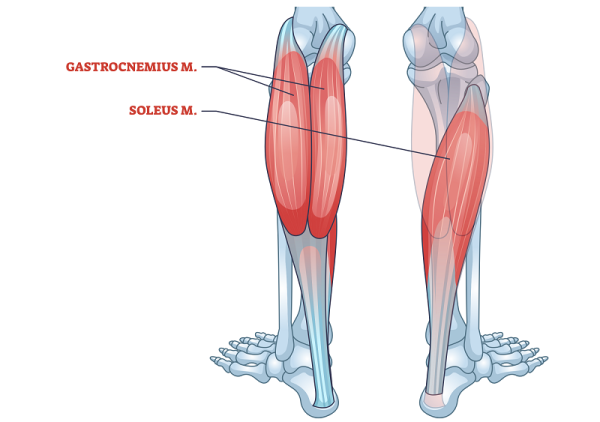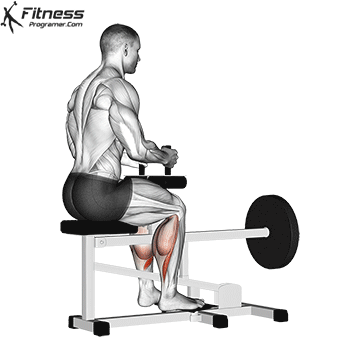Overview
The lever seated calf raise is executed using a specialized machine that applies resistance through a pad positioned over the thighs while the feet press against a platform. The movement involves plantarflexing the ankles, lifting the heels against resistance, and lowering them back to a full stretch. It’s one of the most effective exercises for developing the soleus, which is essential for stability, posture, and lower-limb performance during walking, running, and jumping.
How to Perform Lever Seated Calf Raise
Setup: Sit on the machine with your knees bent at 90 degrees, feet placed shoulder-width on the foot platform. The thigh pad should rest securely on top of your thighs, just above the knees.
Adjust Load: Load the desired weight onto the lever arms. Start conservatively and focus on full range of motion.
Start Position: Release the safety mechanism. Let your heels lower slowly to feel a deep stretch in the calves.
Raise: Press through the balls of your feet to lift your heels as high as possible, focusing on strong contraction in the soleus.
Pause and Contract: Hold at the top for 1–2 seconds, fully contracting the calves without bouncing.
Lower Under Control: Let your heels return to the starting position under slow, deliberate control for a full eccentric stretch.
Repeat: Perform the desired number of reps while maintaining strict form.
Tips for Proper Form
Avoid bouncing: Use slow, deliberate movement—especially at the bottom of the rep.
Keep knees and hips still: Do not use momentum or shift the thighs upward to aid the lift.
Control the eccentric: Emphasize the lowering phase for added hypertrophic benefit.
Use a full range of motion: Allow a full stretch and complete heel lift.
Pause at the top: Briefly hold for 1–2 seconds to enhance mind-muscle connection with the soleus.
Common Mistakes
Rushing reps and using momentum, reducing tension on the soleus.
Partial range of motion, limiting calf development.
Letting the knees lift off the pad, which decreases mechanical efficiency.
Using too much weight, compromising control and increasing injury risk.
Neglecting eccentric control, missing a key stimulus for muscle growth.
Benefits of the Lever Seated Calf Raise
Isolates the soleus: Knee flexion reduces gastrocnemius dominance, enhancing soleus activation.
Promotes joint stability: Strong soleus muscles support the ankle and improve balance.
Improves lower leg endurance: Useful for runners, cyclists, and field athletes.
Joint-friendly: Seated position reduces axial loading, making it ideal for those with back or hip limitations.
Facilitates high-rep training: Excellent for burnout sets due to machine-assisted stability and minimal balance demands.
Enhances posture and gait: A strong soleus contributes to upright posture and efficient walking mechanics.
Supports Achilles tendon resilience: Controlled eccentric loading helps strengthen tendon tissue.
How to Incorporate Into Your Routine
For Beginners: Start with 2–3 sets of 15–20 reps using moderate resistance to master control and technique.
For Hypertrophy: Perform 3–5 sets of 15–30 reps, focusing on time under tension and peak contraction.
For Strength: Use heavier resistance for 4 sets of 8–12 reps, maintaining full control and range of motion.
For Endurance Training: Use high reps (20+) at the end of a lower-body circuit to fully fatigue the soleus.
For General Fitness: Add 2–3 sets at the end of leg day to improve calf development and ankle function.
For Athletic Performance: Use 2–3 sets of high-rep seated raises post-training to promote tendon health and endurance in the lower leg.
Lever Seated Calf Raise: Muscles Worked

Frequently Asked Questions
How is this different from a standing calf raise?
Standing calf raises target both the gastrocnemius and soleus. In the seated variation, knee flexion deactivates the gastrocnemius, allowing the soleus to take on most of the load.
Why train the soleus separately?
The soleus is highly fatigue-resistant and critical for postural endurance. It responds well to high-rep, high-frequency training and plays a central role in ankle and foot mechanics.
Can I use dumbbells or plates instead of a machine?
Yes, if a machine is unavailable, you can place a barbell or dumbbells on the thighs while seated with feet elevated, though the machine provides superior stability and consistent loading.
How often should I do seated calf raises?
The soleus can tolerate frequent training—2–3 times per week, especially if using varied rep ranges and tempo techniques.
How long should I rest between sets?
For hypertrophy, rest 30–60 seconds. For strength development, rest 60–90 seconds.

